
MEAL PREPARATION,
PART II
Unit Overview
Using proper preparation techniques will enable you to prepare foods in a healthier manner. To get the most of the nutrients in food, the food must be stored, handled, and prepared using proper techniques.
Plan ahead. During this unit you will prepare two different recipes of food. Look over the recipes and make a decision as to which you will make. This will enable you to buy the ingredients you need so they are on hand when you are ready to prepare the food. To print out all of the recipes click on the PDF File.
Directions for
printing a PDF File

Recipe Options
● Remember
common abbreviations used in cooking:
|
Common Abbreviations |
|
|
t or tsp |
teaspoon |
|
T or Tbsp |
tablespoon |
|
c |
cup |
●When baking
times in recipes are ranges (15-20 minutes), set the timer for the shorter
amount of time. You can always add more time. If you set the timer for 20
minutes and it is too long, you cannot “uncook” the food.
●When a recipe calls for softened margarine, it does not mean
melted

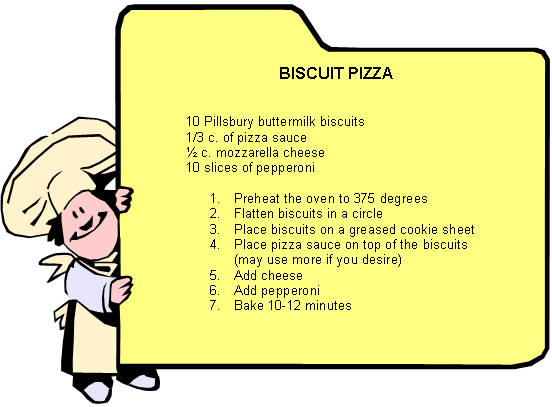
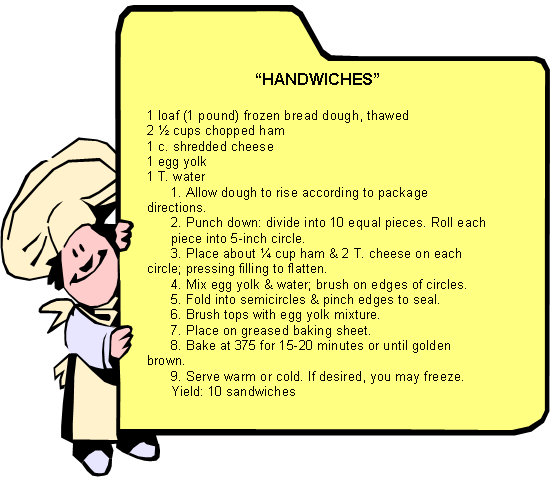
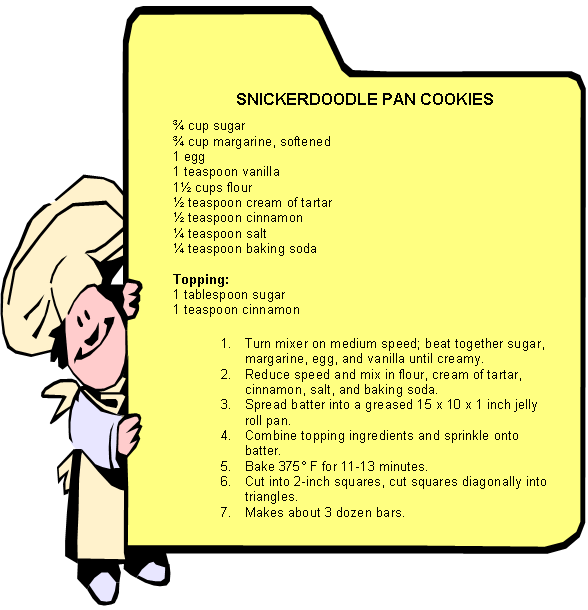
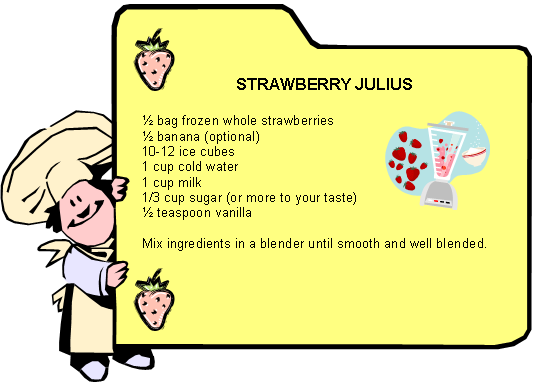

|
Key Terms |
||
|
Utensils |
Appliances |
Large equipment |
|
Conventional oven |
Convection oven |
Microwave |
|
Large appliances |
Small appliances |
Dice |
|
Mince |
Peal |
Stir |
|
Cut in |
Whip |
Fold |
|
Breaded |
Cookware |
Bakeware |
|
Nonstick surfaces |
Griddle |
Double boiler |
|
Skillet |
|
|








Kitchen Equipment
 Kitchens
are equipped with a variety of appliances based on the needs, income, skills,
and interest of families who use them. Appliances are kitchen equipment powered
by electricity or gas. Utensils are containers, cookware, and tools with no
power sources.
Kitchens
are equipped with a variety of appliances based on the needs, income, skills,
and interest of families who use them. Appliances are kitchen equipment powered
by electricity or gas. Utensils are containers, cookware, and tools with no
power sources.
Two large appliances in most kitchens are refrigerator-freezers and ranges. Refrigerator-freezers are used for storing foods that must chilled or frozen. Features on refrigerator-freezers vary. For example, freezer sections may be above, below, or along side the refrigerator sections. Another option in many freezers is the self-defrosting feature that saves owners the time of not having to defrost freezers. A third option is a humidity controlled area for storing meats and fruits. Some refrigerators have ice and water dispensers built into the doors.
Ranges are used for cooking food. They may be a single appliance with burners and an oven or a separate cook-top and oven. Most ranges have three or four burners. A separate dial controls each burner and allows the user to adjust the heat. The oven dial allows the user to select an appropriate temperature for reheating food, baking, roasting, and keeping food warm until serving time. Three types of ovens used today include
Ø The conventional oven that heats the air around the food, which in turn heats and cooks the food.
Ø The convection oven that also heats the air around the food resulting in heating the food. The difference is that the convection oven includes a fan that circulates the hot air and cooks the food faster.
Ø Microwave ovens turn electricity into microwaves that cook food by friction. Rub your hands together. You can feel them warming up. This is the principle of microwave ovens. Food molecules vibrate and rub against each other cooking the food. Micro-waved food usually cooks in ¼ the time it does in a conventional oven. (More information on microwave ovens is found later in this lesson.)
Other large appliances in the kitchen may include a dish washer, garbage disposal, and trash compactor. Dish washers have a wide range of features. Some have time delays so the dishes are washed while the family is sleeping and the demand for water usage is reduced.
A wide variety of small appliances that aid food preparation are on the market today. Common small appliances include: mixers (both hand held and stand), electric skillets, crock pots (slow cookers), blenders, toaster ovens, and food processors.
Small and large appliances should be cleaned after each use. Refrigerators should be cleaned regularly.
![]() Now answer questions 1-13.
Now answer questions 1-13.

Cutting Foods
Cutting utensils include pizza cutters, knives, peelers, and kitchen sheers. Small appliances that perform cutting tasks include blenders and food processors. Knives should match the task. Paring knives are small and often used to peel fruits and vegetables. Bread knives have serrated (saw tooth) edges. They are useful for cutting bread because the serrated edges do not mash the bread as much as a smooth knife.
Helpful cutting tips
ü Keep knife blades sharp; you are less likely to get cut because you do not have to use as much force.
ü Always use a cutting board to protect the counter, help prevent dulling the knife, and to keep the food from slipping.
ü Always cut away from yourself.
ü Never hold food in your hand when you are cutting.
ü Hold food with your fingers tucked back when you are cutting.
ü If you drop a knife, let it fall; it is not safe to try and catch it.
ü When washing knives, do not place them in sudsy dish water. The suds keep you from seeing where the knife blade is and you may get cut.
ü Buy knives with the blade riveted into the handle (tang); these blades are less likely to break when you apply pressure as you are cutting.
Several terms refer to cutting techniques. Each technique results in a different product.
Ø Dicing is cutting food into small pieces by cutting in three directions.
Ø Mincing is cutting into pieces as small as possible.
Ø Peeling or paring is taking skin off fruits or vegetables.
![]() Now answer questions 14-23.
Now answer questions 14-23.
Mixing Equipment
To mix your food you will need a bowl and a utensil or piece of small equipment to do the stirring. Spoons, whisks, mixers, blenders, pastry blenders, and food processors all are useful when mixing food. For a well prepared final dish, you need to follow the instructions in your recipe. With an electric mixer the speed will determine how much air is incorporated into the food you are mixing. The faster the speed, the more air which is beat into the food.
A pastry blender has a handle across the top and wires bent in a u-shape fasten on to each end of the handle. It is used to “cut in” the shortening or fat into dry ingredients. This process is used for making biscuits and pie crust. A rotary beater is held with one hand while you use the other hand to turn the handle. It is used for thin batters and eggs. A hand mixer is electric, held in your hand, and has a variety of different speeds. A wire whisk is used to blend, stir, and whip ingredients.
Helpful tips for
mixing ingredients include (Glosson):
- Select a bowl which appropriate to the amount of ingredients you are using and the mixing methods you will be doing.
- Choose the appropriate mixing tools for what you are trying to do.
- To keep the mixing bowl from sliding around on the counter or table, place a damp towel underneath of it.
- Use a rubber scraper to get all of the batter mixture out of the bowl.
- When adding dry ingredients to liquid ingredients, add just a little bit at a time. Stir until all the dry ingredients have disappeared and then add more dry ingredients. Repeat until all of the ingredients have been added.
Some of the mixing
terms used in recipes are defined for you.
![]() Stir means to slowly mix in the ingredients with
a spoon or wire whisk.
Stir means to slowly mix in the ingredients with
a spoon or wire whisk.
![]() “Cut in” means to break the fat up into small
pieces similar to the size of rice.
“Cut in” means to break the fat up into small
pieces similar to the size of rice.
![]() Whip means to use a fast speed on the mixer.
Whipping incorporates air into the food
Whip means to use a fast speed on the mixer.
Whipping incorporates air into the food
and causes the food to increase in volume.
![]() Fold means you mix by turning over the mixture
so you do not lose the air you have beaten into an ingredient such as
eggs.
Fold means you mix by turning over the mixture
so you do not lose the air you have beaten into an ingredient such as
eggs.
![]() Now answer questions 24-34.
Now answer questions 24-34.
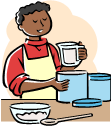
Special Instructions
If a recipe calls for an egg to be separated, you divide the white from the yolk. An egg separator is used for this task. To separate an egg, place the egg separator across the top of a small bowl. Crack the egg and pour it into the center of the egg separator. The yolk will stay in the center section, and the egg white will drain into the bowl. If no egg separator is available you can achieve the same results by pouring the egg back and forth between the two egg shell halves. Do this over an empty bowl. Egg yolk contains fat that prevents eggs from forming into the soft peak stage needed to make meringues. If a recipe calls for breading a food such as chicken or fish, cover the food item with a thin layer of flour, cornmeal, or crumbs before cooking it. You can roll the food in the coating or place the food and the coating in a plastic bag, seal the bag and shake it to coat the food.
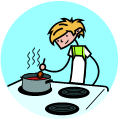
Cooking Equipment
Pots and pans used for cooking on top of burners are called cookware. Pans and dishes used in the oven are called bakeware. Both come in a variety of sizes. Cookware pieces usually have lids to keep steam and nutrients in food as it cooks. Most cookware also has handles
for lifting and moving the pan even when it is hot. You should still use a hot pad or oven mitt to protect your hand from the hot pan.
A variety of materials are used to make bakeware and cookware. These materials affect the cost, how long product lasts, and how well it conducts heat. Some commonly used materials are listed below. (Glosson)
o Aluminum, light weight and durable, heats evenly and quickly. A disadvantage is that it darkens and stains easily.
o Stainless steel heats slowly and evenly, but it is strong.
o Enamel pots and pans cannot be scoured, and they chip easily.
o Cast-iron pots and skillets are heavy and heat well, but they rust easily if they are not dried well.
o Glass and glass-ceramic are strong and can be used to freeze foods and then bake them. If you are doing this, put the dish in the oven as the oven is heating; otherwise, the dish may crack. The dish may break if it is dropped.
o Plastic cookware is strong and easy to clean. Some plastic cookware is designed to only be used in microwave ovens and not in conventional ovens.
![]() Now answer questions 35-47.
Now answer questions 35-47.
Nonstick surfaces clean easily, but they may scratch easily if you do not use the correct utensils. Nonstick pans allow you to cook with little or no fat.
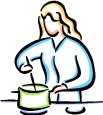
Some types of cookware are listed below (Glosson):
v A griddle is a flat pan used for eggs and pancakes.
v A double boiler is made of two pans; one sits inside the other. Water is in the bottom pan, and food is in the top pan. As the water heats, steam is created and rises to heat the food in the top pan. Double boilers are used to heat foods, such as chocolate, that scorch easily.
v A pot, larger than a saucepan, has two handles and a lid. It is used for pasta and soups.
v A skillet has low sides, a handle, a lid, and is used for frying foods.
v A Dutch oven is a large pot used to slow cook meats.
v A saucepan, sold in a variety of sizes, has a long handle and a lid.
Bakeware include the following (Glosson):
§ Baking sheets are large flat pans used for baking cookies. They sometimes have short sides; other times they are flat.
§ Loaf pans are deep-sided rectangular pans used for baking bread.
§ Roasting pans, used for roasting meats, are large, shallow pans with flat bottoms.
§ Muffin pans come in 6 or 12 individual sections and are used to make muffins and cupcakes.
§ Casserole dishes can be used for baking and serving foods. Casserole dishes often have lids and small handles.
§ Pie pans are round with sides that are wider at the top and sloped in to the bottom. They are used for baking pies.
§ Broiler pans are shallow pans with grates. Placing food on the grate allows fat to drip off of the food. Broiling is a good method for preparing food with less fat.
§ Cake pans have straight sides and may be circular, square, or rectangle shaped.
![]() Now answer questions 48-61.
Now answer questions 48-61.

Microwave Cooking
A microwave is a short, high-frequency radio wave made by a magnetron tube from
electricity. A stirrer blade or fan in the top of the microwave oven distributes microwaves throughout the oven and through the cooking dish and the food. Metal cannot be used in the microwave because waves cannot pass through it, and arcing occurs.
Microwave ovens are used for reheating foods, cooking small amounts of food, and defrosting frozen foods. Turntables aid in cooking food more evenly. Because the appearance of food changes very little in the microwave, microwaved meats are not very appealing. Breads can be baked in microwaves but they will not brown well either.
Microwave power is measured in watts; most microwave ovens are between 700 watts and 850 watts. Larger microwave ovens may be up to 1050 watts. Smaller watt ovens take longer to cook the same food than a higher watt oven. Today’s ovens have digital control panels that
offer a wide selection of power settings.
Several types of cookware can be used in microwave ovens. Usually glass, plastic, and ceramic dishes are suitable. Always check to see if they are labeled microwave safe. Metal pans cannot be used in the microwave oven; they create arcing (sparks) can damage the oven and start a fire. Small pieces of aluminum foil may be used to shield foods. Shielding is covering parts of the food that might overcook. Aluminum foil prevents the microwaves from reaching this part of the food. When using foil, you can prevent arcing by making sure the foil does not touch the sides of the oven.

Microwaves travel about 1 ½ inches into the food. Heat from the molecules rubbing together moves toward the center of the food and cooks it. Cooking the center of the food obviously will take longer. Therefore recipes suggest stirring foods, such as stews, so the heat is distributed more evenly. Stir from the outer edge toward the center. Rotating, or turning the food around ¼ or ½ way, also helps cook food more evenly. Another way to cook foods more evenly is to turn them over.
Covering food when it is cooking in the microwave oven helps retain moisture and keeps it from splashing the inside walls of the microwave oven. Appropriate covers for foods in microwave ovens are listed below:
ü Paper towels or napkins; wrapping bread in paper towels keeps it from getting soggy.
ü Waxed paper allows some steam to escape while keeping in moisture.
ü Dishes with lids.
ü Microwave-safe plastic wrap can be used, but because it forms a tight seal always pierce the top of the plastic wrap or turn back one core to prevent the steam build-up. Foods covered with skin or sealed in plastic should be pierced with a fork or make slits with a knife. This prevents steam from building up inside the food and possibly causing it to explode.
Standing time is an important part of microwave cooking. Molecules in the food continue to move and cook the food even after the oven is off. Times on recipes indicate actual cooking time in the oven; the food continues to cook during the standing time, and the outside edges are not overcooked.
Pasta products are not often cooked in microwave ovens because they take as long to cook in microwaves as they do on stovetops. Pasta products need time to absorb water so they soften.
Several things affect microwave times for cooking foods. (Glosson)
- Food moisture, fat, and sugar content-Foods high in water, fat, and sugar heat quickly. Sections of food high in fat or sugar cook faster than other parts of the food and create hot spots. Season food after microwaving because salt attracts microwaves.
- Density-Denser foods take longer to cook in the microwave oven.
- Volume-When you cooking a large amount of food, it may take as long as it would in a conventional oven.
- Shape- Unevenly shaped foods cook unevenly. If food has thinner and thicker sections, place the thinner sections toward the center of the oven and the thicker parts toward the outside. Placing them like the spokes of a bike wheel helps.
- Starting temperature-Refrigerated or frozen foods take more time to cook than those starting at room temperature.
Safety rules for microwave ovens (Glosson)
v When removing covering from a dish heated in a microwave oven, always open the edge away from you to allow the steam to escape and prevent your getting burned. This method should also be used when you remove lids from any pans you are using on a range top. Dishes not microwave safe may melt or shatter in the microwave so always check to be sure they are safe. To do this put ½ cup water in the container and put it in the oven on high power for 1 minute. Check to see if the water is hot. If the water is hot and the dish is not, it is good to use. If the dish is hot and water is not, do not use it because the dish is absorbing the microwaves and it may crack.
v Microwave ovens must be grounded with a three-prong plug. Do not use extension cords.
v Keep the microwave oven clean. Food splashed on the sides, top, and bottom of the oven will increase cooking times.
![]() Now answer questions 62-84.
Now answer questions 62-84.
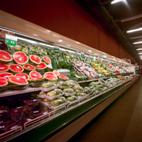
Storing Foods
Pasta, keeps well in air tight containers. Rice and flour also stays fresh for long periods in
airtight containers. Whole-grain flour should be stored in a refrigerated because of the fat content in the germ. Bread products should be stored in airtight containers to prevent the food from drying out.
Spoilage, caused by bacteria, molds, or yeasts, makes food look or smell bad. Proper storage helps prevent spoilage of fresh fruits and vegetables. A lot of produce must be refrigerated. Leafy vegetables such as lettuce should be kept refrigerated in airtight containers to keep them moist. Some fruits, such as bananas, ripen if you leave them at room temperature. A cool, dark place is best for storing potatoes and onions. Most fresh fruit will not keep for long periods of time and, therefore, should be used within a few days.
Frozen fruits and vegetables keep for several months if the freezer temperature is 0° F or colder. They keep a few weeks if the temperature is 10° to 15° F. If stored in a dry, cool place, canned fruits and vegetables last for a year or more. The temperature should be cooler than 70°F. Dried fruits and vegetables keep well on cabinet shelves, but when the air is humid, they should be refrigerated.
Most dairy products are perishable, meaning they spoil easily. Milk can usually be stored at least a week in your home refrigerator. Heat and light both affect the quality of milk. Harmful bacteria grow when the milk is warm, and light destroys the B vitamin, riboflavin.
Meat, poultry, and fish should be refrigerated in their original wraps or containers and only for a couple of days. For longer periods, you may freeze the meat. Be sure it is wrapped so no air can get to it. When air touches food stored in the freezer, it creates freezer burn, a dry, pale frosty area. Freezer burn lessens the quality of the meat.
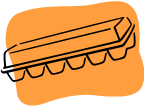
Eggs stored in their original cartons are less likely to absorb odors from other foods in the refrigerator. Eggs remain fresh for up to three weeks.
![]() Now answer questions 85-95.
Now answer questions 85-95.

 |
| Unit 16 Meal Preparation, Part II (Unscramble) Worksheet |
| Unit 16 Meal Preparation (Advance Organizer) Worksheet |